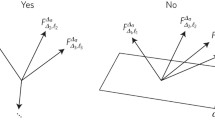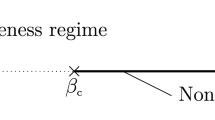Abstract
We report results about a rigorous microscopic justification of the Wulff construction for the two-dimensional Ising model at low temperatures and under periodic boundary conditions. The idea of the proof is sketched.
Similar content being viewed by others
References
J. W. Gibbs, On the equilibrium of heterogeneous substances, inThe Scientific Papers of J. Williard Gibbs, Vol. 1,Thermodynamics (Longmans, Green & Co., 1906), pp. 315–326.
P. Curie, Sur la formation des crystaux et les constants de capillarité de leur different phase,Bull. Soc. Fr. Minéral. 8:145–150 (1885).
G. Wulff, Zur Frage der Geschwindigkeit des Wachstums und der Auflösung der Krystallflachen,Z. Krystallogr. Mineral. 34:449 (1901).
M. von Laue, Der Wulffsche Satz für die Gleichgewichtsform von Kristallen,Z. Krist. 105:124–133 (1943).
C. Herring, Some theorems on the free energies of crystal surfaces,Phys. Rev. 82:87–93 (1951).
J. C. Heyraud and J. J. Métois, Establishment of the equilibrium shape of metal crystallites on a foreign substrate: Gold on graphite,J. Cryst. Growth 50:571–574 (1980).
J. C. Heyraud and J. J. Métois, Equilibrium shape and temperature; lead on graphite,Surf. Sci. 128:334–342 (1983).
S. Balibar and B. Castaign, Possible observation of the roughening transition in helium,J. Phys. Lett. (Paris)41:L329–332 (1980).
S. Balibar and B. Castaign, Helium: Solid-liquid interfaces,Surf. Sci. Rep. 5:87–143 (1985).
J. Landau, S. G. Lipson, L. M. Määttänen, L. S. Balfour, and D. O. Edwards, Interface between superfluid and solid4He,Phys. Rev. Lett. 45:31–35 (1980).
P. E. Wolf, S. Balibar, and F. Gallet, Experimental observation of a third roughening transition on hep4He crystals,Phys. Rev. Lett. 51:1366–1369 (1983).
H. van Beijeren and I. Nolden, The roughening transition, inTopics in Current Physics, Vol. 43, W. Schommers and P. von Blackenhagen, eds. (Springer, Berlin, 1987), pp. 259–300.
C. Rottman and M. Wortis, Statistical mechanics of equilibrium crystal shapes: Interfacial phase diagrams and phase transitions,Phys. Rep. 103:59–79 (1984).
R. K. P. Zia, Anisotropic surface tension and equilibrium crystal shapes, inProgress in Statistical Mechanics, C. K. Hu, ed. (World Scientific, Singapore, 1988), pp. 303–357.
W. K. Burton, N. Cabrera, and F. C. Grank, The growth of crystals and the equilibrium structure of their surfaces,Phil. Trans. R. Soc. 243A:40–359 (1951).
R. L. Dobrushin, R. Kotecký, and S. Shlosman,The Wulff Construction: A Global Shape from Local Interactions (AMS, Providence, Rhode Island, 1992).
G. Gallavotti, Instabilities and phase transitions in the Ising model. A review,Nuovo Cimento 2:133–169 (1972).
H.-O. Georgii,Gibbs Measures and Phase Transitions (Walter de Gruyter, Berlin, 1988).
M. Aizenman, S. Goldstein, and J. L. Lebowitz, Conditional equilibrium and the equivalence of microcanonical and grandcanonical ensembles in the thermodynamic limit,Commun. Math. Phys. 62:279–302 (1978).
R. L. Dobrushin and B. Tirozzi, The central limit theorem and the problem of equivalence of ensembles,Commun. Math. Phys. 54:173–192 (1977).
K. M. Halfina, The limiting equivalence of the canonical and grand canonical ensemble (low density case),Mat. Sb. 80(122):3–51 (1969) [Math. USSR Sb. 9:1–52 (1969)].
R. A. Minlos and A. Haitov, Limiting equivalence of thermodynamic ensembles in case of one-dimensional system,Tr. Mosk. Mat. Obshch. 32:147–186 (1975) [Trans. Mosc. Math. Soc. 32:143–180 (1975)].
R. L. Thompson,Equilibrium States in Thin Energy Shells (Memoirs of the American Mathematical Society, Vol. 150, 1974).
H.-O. Georgii,Canonical Gibbs Measures (Springer-Verlag, Berlin).
R. A. Minlos and Ja. G. Sinai, The phenomenon of “phase separation” at low temperatures in some lattice models of a gas I,Mat. Sb. 73:375–448 (1967) [Math. USSR Sb. 2:335–395 (1967)].
R. A. Minlos and Ja. G. Sinai, The phenomenon of “phase separation” at low temperatures in some lattice models of a gas II,Tr. Mosk. Mat. Obshch. 19:113–178 (1968) [Trans. Mosc. Math. Soc. 19:121–196 (1968)].
J. E. Taylor, Some crystalline variational techniques and results,Astŕisque 154–155:307–320 (1987).
C. E. Pfister, Large deviations and phase separation in the two-dimensional Ising model,Helv. Phys. Acta 64:953–1054 (1991).
R. Kotecký and C. Pfister, in preparation.
R. L. Dobrushin, Gibbs state describing coexistence of phases for a three-dimensional Ising model,Teor. Ver. Pril. 17:619–639 (1972) [Theor. Prob. Appl. 17:582–600 (1972)].
P. Holický, R. Kotecký, and M. Zahradník, Rigid interfaces for lattice models at low temperatures,J. Stat. Phys. 50:755–812 (1988).
G. Gallavotti, The phase separation line in the two-dimensional Ising model,Commun. Math. Phys. 27:103–136 (1972).
M. Aizenman, Instability of phase coexistence and translation invariance in two dimensions,Phys. Rev. Lett. 43:407–109 (1979).
M. Aizenman, Translation invariance and instability of phase coexistence in the two dimensional Ising system,Commun. Math. Phys. 73:83–94 (1980).
Y. Higuchi, On the absence of non-translationally invariant Gibbs states for the two-dimensional Ising system,Rigorous Results in Statistical Mechanics and Quantum Field Theory, J. Fritz, J. L. Lebowitz, and D. Szász, eds. (North-Holland, Amsterdam, 1982), pp. 517–534.
R. L. Dobrushin and S. B. Shlosman,The problem of translation invariance of Gibbs fields at low temperatures, Sov. Sci. Rev. Sect. Math. Phys. C5:53–185 (1985).
D. B. Abraham and P. Reed, Diagonal interface in the two-dimensional Ising ferromagnet,J. Phys. A: Math. Gen. 10:L121–123 (1977).
J. E. Avron, H. van Beijeren, L. S. Schulman, and R. K. P. Zia, Roughening transition, surface tension and equilibrium droplet shapes in a two-dimensional Ising system,J. Phys. A: Math. Gen. 15:L81–86 (1982).
J. De Coninck, F. Dunlop, and V. Rivasseau, On the microscopic validity of the Wulff construction and of the generalized Young equation,Commun. Math. Phys. 121:401–419 (1989).
K. Alexander, J. T. Chayes, and L. Chayes, The Wulff construction and asymptotics of the finite cluster distribution for two-dimensional Bernoulli percolation,Commun. Math. Phys. 131:1–50 (1990).
Author information
Authors and Affiliations
Rights and permissions
About this article
Cite this article
Dobrushin, R.L., Kotecký, R. & Shlosman, S.B. A microscopic justification of the Wulff construction. J Stat Phys 72, 1–14 (1993). https://doi.org/10.1007/BF01048037
Received:
Revised:
Issue Date:
DOI: https://doi.org/10.1007/BF01048037




